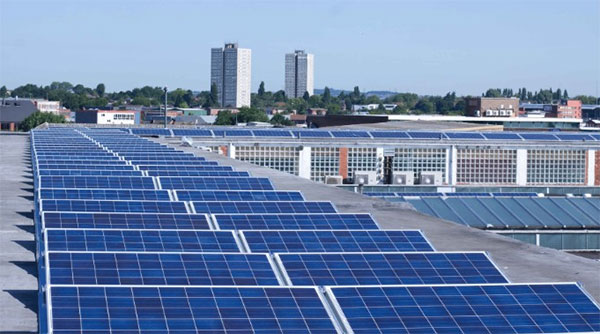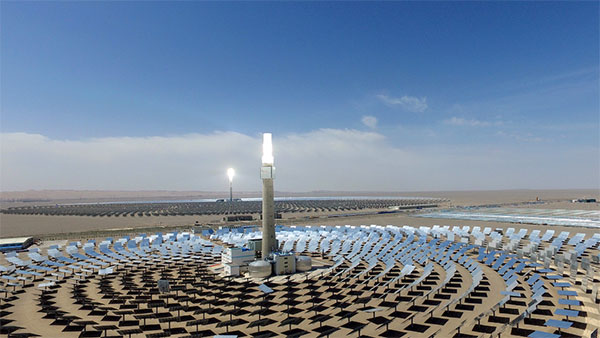Description
The most common commercial solar panel is the monocrystalline type.

The Most Common Commercial Solar Panels
Commercial solar panels are essential in harnessing solar energy for various commercial applications. They transform sunlight into usable electricity, playing a crucial role in renewable energy solutions. The most common types used in commercial environments include monocrystalline, polycrystalline, and thin-film solar panels, each with unique features, efficiency rates, costs, and installation requirements.
Monocrystalline Solar Panels
Monocrystalline solar panels, recognized for their dark black color, are popular due to their high efficiency and sleek appearance. They are made from single-crystal silicon, which allows electrons greater mobility, thereby increasing efficiency.
Key Features:
- Efficiency: Typically, these panels offer an efficiency of about 15-20%.
- Cost: They are generally more expensive than other types, due to the higher purity silicon used.
- Lifespan: Monocrystalline panels often last for 25-30 years.
- Aesthetics: Favored for a uniform look, making them an ideal choice for visible installations.
- More about Monocrystalline Solar Panels
Advantages and Disadvantages:
- Advantages: Higher efficiency means they are suitable for areas with limited space.
- Disadvantages: Higher costs can be a limiting factor for some projects.
Polycrystalline Solar Panels
Made from fragments of silicon crystals melted together, polycrystalline solar panels have a distinctive blue hue. They are a more cost-effective option compared to monocrystalline panels.
Key Features:
- Efficiency: These panels usually have an efficiency rate of around 13-16%.
- Cost: Less expensive than monocrystalline panels, making them a popular choice for businesses with a tighter budget.
- Lifespan: The average lifespan is about 25 years.
- Physical Attributes: They are less space-efficient and have a bluish appearance.
- Details on Polycrystalline Solar Panels
Advantages and Disadvantages:
- Advantages: Cost-effectiveness and lower manufacturing waste.
- Disadvantages: Lower efficiency and less aesthetic appeal compared to monocrystalline panels.
Thin-Film Solar Panels
Thin-film solar panels are made by layering one or more thin layers of photovoltaic material onto a substrate. These panels are known for their lightweight and flexible characteristics.
Key Features:
- Efficiency: They generally have lower efficiency, around 10-13%.
- Cost: The production cost is lower than both monocrystalline and polycrystalline solar panels.
- Lifespan: Shorter lifespan of about 15-20 years.
- Installation: Easier and less costly installation, can be installed in large areas.
- Insights into Thin-Film Solar Panels
Advantages and Disadvantages:
- Advantages: Ideal for large-scale installations and flexible usage scenarios.
- Disadvantages: Lower efficiency and shorter lifespan can affect the long-term return on investment.
Each type of solar panel has its own set of specifications, costs, and suitability for different commercial applications. The choice depends on several factors including the available space, budget, desired efficiency, and specific energy needs of the project. Understanding these options helps businesses make informed decisions aligned with their energy goals and financial plans.

Factors Influencing the Popularity of Commercial Solar Panels
The adoption and popularity of commercial solar panels depend on various factors. Businesses evaluate several aspects to determine the most suitable type of solar panel that aligns with their energy needs and goals.
Efficiency and Performance
Efficiency refers to the ability of a solar panel to convert sunlight into electricity. Higher efficiency rates mean more power generation, which is crucial for maximizing energy production, especially in limited spaces.
- Key Points:
- Higher efficiency panels (about 15-22%) such as monocrystalline panels are often preferred in commercial settings where space is at a premium.
- Performance also depends on the quality of manufacturing, the material of the solar cells, and the technological design. For instance, panels with PERC (Passivated Emitter and Rear Cell) technology tend to have better performance metrics.
- The impact of temperature on performance is another crucial aspect. Solar panels, in general, lose efficiency as they get hotter. Panels with lower temperature coefficients are in demand for installations in warmer climates.
Cost Considerations
The cost of solar panels includes not only the initial purchase price but also long-term expenses related to installation, operation, and maintenance.
- Key Points:
- Polycrystalline solar panels offer a balance between cost and efficiency and are suitable for businesses with moderate budgets.
- While monocrystalline panels come with a higher upfront cost, their superior efficiency and longer lifespan can result in greater savings over time.
- Installation costs can vary significantly based on the complexity of the system, the geographical location, and the type of mounting required.
- Incentives, tax breaks, and rebates can significantly influence the overall cost and ROI of solar panel installations.
Durability and Lifespan
The longevity and robustness of solar panels are critical for ensuring a return on investment over time.
- Key Points:
- Typical commercial solar panels come with a lifespan ranging from 25 to 30 years.
- Durability not only impacts the long-term value but also affects maintenance costs. Panels made with high-quality materials and robust designs endure environmental elements better, reducing the need for frequent repairs or replacements.
- Warranties provided by the manufacturer are a good indicator of the panel's durability. A 25-year warranty is standard among leading manufacturers.
Installation and Maintenance Requirements
Ease of installation and the level of ongoing maintenance required can affect the choice of solar panels for commercial projects.
- Key Points:
- Thin-film panels, being lightweight and flexible, can be easier and less expensive to install on large or unconventional surfaces.
- The complexity of the mounting system, whether on rooftops or ground mounts, can also impact the overall installation cost and time.
- Maintenance involves regular cleaning, checking for any physical damages, and monitoring the system’s performance. Panels requiring minimal maintenance can be more attractive in commercial settings to reduce downtime and additional costs.
Choosing the right solar panel for commercial use involves balancing these factors to achieve the best possible performance, durability, and ROI. Detailed research and a clear understanding of the specific energy needs and environmental conditions are essential in making an informed decision.

Comparing Commercial Solar Panel Brands and Models
In the world of commercial solar panels, various brands compete by offering diverse models with distinct features and benefits. Businesses looking to adopt solar energy must consider different brands and models to find the best match for their specific requirements.
Leading Manufacturers and Their Products
Several manufacturers stand out in the solar panel industry, each known for their quality, innovation, and performance.
- SunPower: Renowned for producing some of the highest efficiency solar panels available. Their X-Series panels, for instance, boast efficiencies of over 22%.
- LG: Known for their NeON series, LG solar panels combine high efficiencies (up to 21.7%) and strong warranties, making them a favored choice for quality-conscious buyers.
- Canadian Solar: Offers a wide range of solar panel options, focusing on both monocrystalline and polycrystalline technologies. They are well-regarded for providing a balance between efficiency (up to 19.88% for the HiKu series) and value.
- Trina Solar: Another leading manufacturer, known for their Vertex series. These panels are popular in commercial installations due to their high power output and efficiency, reaching up to 21%.
- First Solar: Specializes in thin-film technology, particularly suited for large commercial or utility-scale installations. They offer panels with a lower efficiency rate (around 17%) but are advantageous in specific climatic and environmental conditions.
Each manufacturer has unique strengths, such as SunPower's high efficiency or First Solar's thin-film technology, suitable for large-scale installations. Decision-makers should consider these attributes in conjunction with their project's specific needs.
Comparative Analysis of Popular Models
When comparing different solar panel models, it's essential to consider a variety of key performance metrics.
- Efficiency: This is one of the primary parameters. Higher efficiency panels generate more electricity over a smaller area, but often at a higher cost.
- Power Output: Usually measured in watts (W), the power output indicates the electricity generation capacity of a panel under standard test conditions. Commercial panels typically range from 250W to 400W.
- Cost: The price per watt can vary significantly between models and brands. While higher-priced panels might offer better efficiency or quality, budget constraints can influence the final choice.
- Durability and Warranty: Look for panels that can withstand environmental stresses like wind, hail, and temperature fluctuations. A longer warranty period (typically 25 years) also provides assurance of the panel’s longevity and performance.
In comparing solar panels, it's crucial to conduct a thorough analysis based on the project's specific requirements and constraints. Balancing efficiency, cost, durability, and brand reputation will help in selecting the most suitable solar panel model for commercial use.

Case Studies: Commercial Solar Panel Installations
Examining various case studies of commercial solar panel installations offers valuable insights into their practical applications, challenges, and outcomes. These studies range from large-scale solar farms to innovative urban business solutions.
Large-Scale Solar Farms
Large-scale solar farms are pivotal in the generation of renewable energy on a massive scale. One notable example is the deployment of
Tongwei brand solar panels in a large solar farm project.
- Project Details:
- Location & Size: Spanning hundreds of acres, these solar farms often sit in rural or semi-arid regions to capitalize on the available space and high sun exposure.
- Tongwei Solar Panels: Known for their high efficiency and reliability, Tongwei's solar panels are an ideal choice for such large-scale projects. They offer panels with efficiencies exceeding 20%, ensuring optimal energy production in vast installations.
- Energy Output: These solar farms can generate gigawatts of power, contributing significantly to the national grid and aiding in meeting renewable energy targets.
- Economic and Environmental Impact: Beyond renewable energy production, these projects create jobs and stimulate local economies while reducing carbon emissions substantially.
Solar Panels in Urban Business Settings
In urban business environments, solar panel installations must navigate space constraints and aesthetic considerations. Tongwei solar panels, with their high efficiency and sleek design, are well-suited for such settings.
- Implementation Strategies:
- Rooftop Installations: Businesses utilize rooftops to install solar panels, turning unused spaces into energy-generating areas. Tongwei panels, known for their durability and high power output, maximize the energy yield from these limited spaces.
- Building-Integrated Photovoltaics (BIPV): Some businesses incorporate solar panels directly into the building's design, blending functionality with aesthetics. Tongwei's range of solar panels offers versatile options suitable for BIPV applications.
Innovative Uses of Solar Panels in Commercial Projects
Commercial projects increasingly adopt innovative approaches to integrate solar panels, ranging from solar car parks to agricultural photovoltaics.
- Unique Implementations:
- Solar Car Parks: Tongwei solar panels serve in solar car parks where they not only generate power but also provide shade. This dual function is an excellent example of practical and efficient use of space in commercial properties.
- Agrophotovoltaics: Combining agriculture with solar energy, Tongwei panels are used in agrophotovoltaic systems to enable simultaneous crop production and energy generation, maximizing land use efficiency.
Each of these case studies showcases the adaptability and efficiency of solar panels in various commercial contexts. With advancements in technology and increasing awareness of sustainability, the scope of solar panel applications in commercial projects continues to grow, offering innovative solutions to modern energy challenges.







